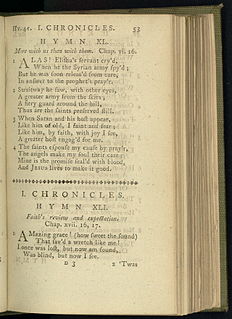 W
W"Amazing Grace" is a Christian hymn published in 1779, with words written in 1772 by the English poet and Anglican clergyman John Newton (1725–1807). It is an immensely popular hymn, particularly in the United States, where it is used for both religious and secular purposes.
 W
WCarl Nielsen's At the Bier of a Young Artist for string orchestra, FS 58, was written for the funeral of the Danish painter Oluf Hartmann in January 1910.
 W
WThe Breathing Permit of Hôr or Hor Book of Breathing is a Ptolemaic era funerary text written for a Theban priest named Hôr. The breathing permit or Book of Breathing assisted its owner in navigating through the afterlife, being judged worthy and living forever.
 W
WCantus in Memoriam Benjamin Britten is a short canon in A minor, written in 1977 by the Estonian composer Arvo Pärt, for string orchestra and bell. The work is an early example of Pärt's tintinnabuli style, which he based on his reactions to early chant music. Its appeal is often ascribed to its relative simplicity; a single melodic motif dominates and it both begins and ends with scored silence. However, as the critic Ivan Hewett observes, while it "may be simple in concept...the concept produces a tangle of lines which is hard for the ear to unravel. And even where the music really is simple in its audible features, the expressive import of those features is anything but." A typical performance lasts about six and a half minutes.
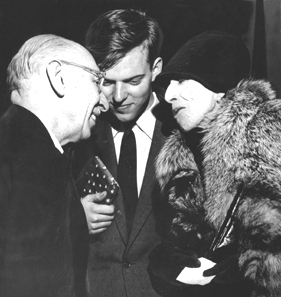 W
WThe Double Canon is a short composition for string quartet by Igor Stravinsky, composed in 1959. It lasts only about a minute and a quarter in performance.
 W
WElegy on the Death of Daughter Olga, JW 4/30 is a cantata for tenor solo, mixed choir and pianoforte, written by the Czech composer Leoš Janáček in 1903. It was written to commemorate the death of composer's daughter, Olga Janáčková. Janáček composed the piece to the text of the Russian teacher Marfa Nikolayevna Veveritsa.
 W
WEpitaphium is a composition for string trio by Graham Waterhouse. In 2007, after the death of his father William Waterhouse, he composed Epitaphium in Memoriam W.R.W. as a tribute to his memory.
 W
W"Final Distance" is a song by Japanese recording artist Hikaru Utada for their third studio album Deep River (2002). Written by Utada themself, the song was produced and composed by long-time collaborators Akira Miyake, Utada's father Teruzane Utada and themself. "Final Distance" was originally recorded as "Distance" which was taken from the album with the same name, despite not being a single. The song was re-recorded and re-arranged after Utada learned that a young girl, who was inspired by Utada, had been murdered during the Osaka school massacre.
 W
WFunérailles is the 7th and one of the most famous pieces in Harmonies poétiques et religieuses, a collection of piano pieces by Franz Liszt. It was an elegy written in October 1849 in response to the crushing of the Hungarian Revolution of 1848 by the Habsburgs.
 W
WGrande symphonie funèbre et triomphale, Op. 15, is the fourth and last symphony by the French composer Hector Berlioz, first performed on 28 July 1840 in Paris. It is one of the earliest examples of a symphony composed for military band.
 W
WKlagt, Kinder, klagt es aller Welt, also known as Köthener Trauermusik, BWV 1143, BWV 244a, is a cantata by Johann Sebastian Bach. He composed it in 1729 for the funeral of Leopold, Prince of Anhalt-Köthen. The music is lost, but the libretto survives. As Bach is known to have used musical material which also appeared in two surviving works, one being the St Matthew Passion, it has been possible to make reconstructions.
 W
WLaß, Fürstin, laß noch einen Strahl is a secular cantata composed as a funeral ode by Johann Sebastian Bach, first performed on 17 October 1727. In Wolfgang Schmieder's catalogue of Bach's works (BWV) it was assigned the number 198. It is also known as Trauerode or as Trauerode: auf den Tod der Königin Christiane Eberhardine.
 W
WHomenaje a Federico García Lorca is a work for chamber orchestra by the Mexican composer Silvestre Revueltas.
 W
WFrédéric Chopin's Piano Sonata No. 2 in B-flat minor, Op. 35, is a piano sonata in four movements. Chopin completed the work while living in George Sand's manor in Nohant, some 250 km (160 mi) south of Paris, a year before it was published in 1840. The first of the composer's three mature sonatas, the work is considered to be one of the greatest piano sonatas of the literature.
 W
WMetamorphosen, study for 23 solo strings is a composition by Richard Strauss for ten violins, five violas, five cellos, and three double basses, typically lasting 25 to 30 minutes. It was composed during the closing months of the Second World War, from August 1944 to March 1945. The piece was commissioned by Paul Sacher, the founder and director of the Basler Kammerorchester and Collegium Musicum Zürich, to whom Strauss dedicated it. It was first performed on 25 January 1946 by Sacher and the Collegium Musicum Zürich, with Strauss conducting the final rehearsal.
 W
WNänie is a composition for SATB chorus and orchestra, Op. 82 by Johannes Brahms, which sets to music the poem "Nänie" by Friedrich Schiller. Brahms composed the piece in 1881, in memory of his deceased friend Anselm Feuerbach. Nänie is a lamentation on the inevitability of death; the first sentence, "Auch das Schöne muß sterben", translates to "Even the beautiful must die". Typical duration of a performance is approximately 15 minutes.
 W
WAn Oxford Elegy is a work for narrator, small mixed chorus and small orchestra, written by Ralph Vaughan Williams between 1947 and 1949. It uses portions of two poems by Matthew Arnold, "The Scholar Gipsy" and "Thyrsis". The first performance took place privately, whilst the public premiere took place in Oxford in June 1952, with Steuart Wilson as the speaker and Bernard Rose conductor.
 W
WPictures at an Exhibition is a suite of ten pieces—plus a recurring, varied Promenade—composed for piano by Russian composer Modest Mussorgsky in 1874.
 W
WGötterdämmerung, WWV 86D, is the last in Richard Wagner's cycle of four music dramas titled Der Ring des Nibelungen. It received its premiere at the Bayreuth Festspielhaus on 17 August 1876, as part of the first complete performance of the Ring.
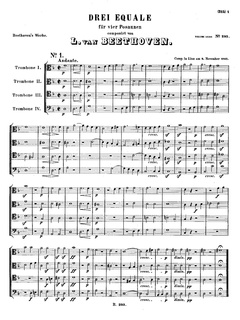 W
WThe Three Equals for four trombones, WoO 30, are three short equals for trombones by Ludwig van Beethoven.
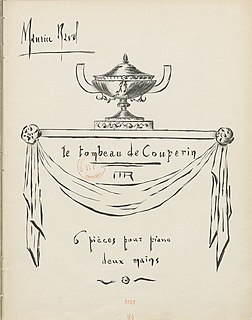 W
WLe Tombeau de Couperin is a suite for solo piano by Maurice Ravel, composed between 1914 and 1917. The piece is in six movements, based on those of a traditional Baroque suite. Each movement is dedicated to the memory of a friend of the composer who had died fighting in World War I. Ravel also produced an orchestral version of the work in 1919, although this omitted two of the original movements.
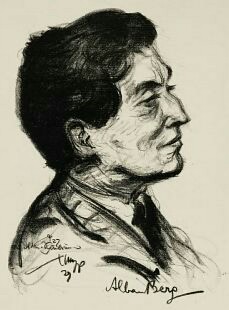 W
WAlban Berg's Violin Concerto was written in 1935. It is probably Berg's best-known and most frequently performed instrumental piece, in which the composer sought to reconcile diatonicism and dodecaphony. Berg composed it on a commission from Louis Krasner, and it became the last work that he completed. Krasner performed the solo part in the premiere at the Palau de la Música Catalana, Barcelona, on 19 April 1936, after the composer's death.